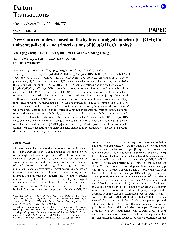摘要
Four new Cu(II) complexes {[Cu-4(bpy)(4)(OH)(4)(H2O)(2)]}(NO3)(2)(C7H5O2)(2)center dot 6H2O 1, {[Cu-4(bpy)(4)(OH)(4)(H2O)(2)]}(NO3)(2)(C5H6O4)center dot 8H(2)O 2, {[Cu-4(bpy)(4)(OH)(4)(H2O)2]}(C5H6O4)(2)center dot 16H(2)O 3 and {[Cu-6(bpy)(6)(OH)(6)(H2O)(2)]}(C8H7O2)(6)center dot 12H(2)O 4 were synthesized (bpy = 2,2'-bipyridine, H-2(C5H6O4) = glutaric acid, H(C7H5O2) = benzoic acid, H(C8H7O2) = phenyl acetic acid). The building units in 1-3 are the tetranuclear [Cu-4(bpy)(4)(H2O)(2)(mu(2)-OH)(2)(mu(3)-OH)(2)](4+) complex cations, and in 4 the hexanuclear [Cu-6(bpy)(6)(H2O)(2)(mu(2)-OH)(2)(mu(3)-OH)(4)](6+) complex cations, respectively. The tetra- and hexanuclear cluster cores [Cu-4(mu(2)-OH)(2)(mu(3)-OH)(2)] and [Cu-6(m(2)-OH)(2)(mu(3)-OH)(4)] in the complex cations could be viewed as from step-like di- and trimerization of the well-known hydroxo-bridged dinuclear [Cu-2(mu(2)-OH)(2)] entities via the out-of-plane Cu-O(H) bonds. The complex cations are supramolecularly assembled into (4,4) topological networks via intercationic pi...pi stacking interactions. The counteranions and lattice H2O molecules are sandwiched between the 2D cationic networks to form hydrogen-bonded networks in 1-3, while the phenyl acetate anions and the lattice H2O molecules generate 3D hydrogen-bonded anionic framework to interpenetrate with the (4,4) topological cationic networks with the hexanuclear complex cations in the channels. The ferromagnetic coupling between Cu(II) ions in the [Cu-4(mu(2)-OH)(2)(mu(3)-OH)(2)] cores of 1-3 is significantly stronger via equatorial-equatorial OH- bridges than via equatorial-apical ones. The outer and the central [Cu-2(OH)(2)] unit within the [Cu-6(mu(2)-OH)(2)(mu(3)-OH)(4)] cluster cores in 4 exhibit weak ferromagnetic and antiferromagnetic interactions, respectively. Results about i.r. spectra, thermal and elemental analyses are presented.
- 出版日期2011
- 单位宁波大学
